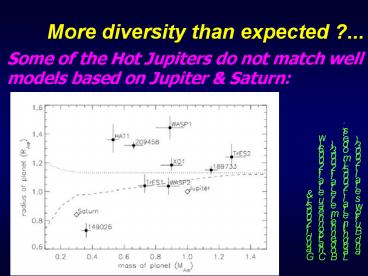More diversity than expected ?... - PowerPoint PPT Presentation
Title:
More diversity than expected ?...
Description:
Gas gun (up to 0.8 Mbar only) Pulsed ... matches Gas gun & Pulsed current (Z-machine) results ... the case of OGLE-TR-132b high-Z and large core needed ? ... – PowerPoint PPT presentation
Number of Views:35
Avg rating:3.0/5.0
Title: More diversity than expected ?...
1
More diversity than expected ?...
Some of the Hot Jupiters do not match well models
based on Jupiter Saturn
Gaudi (2005) Charbonneau et al (2006) w
Bodenheimer et al.(2003), Laughlin et al. (2005)
models and Burrows et al. (2003)
2
Interiors of Giant Planets
- Our own Solar System Jupiter Saturn
- Constraints M, R, age, J2, J4, J6
- EOS is complicated
- mixtures of molecules, atoms, and ions
- partially degenerate partially coupled.
- EOS Lab Experiments (on deuterium)
- Laser induced - LLNL-NOVA
- Gas gun (up to 0.8 Mbar only)
- Pulsed currents - Sandia Z-machine
- Converging explosively-driven - Russia (up to
1.07 Mbar)
3
Phase diagram (hydrogen)
Guillot (2005)
4
Interiors of Giant Planets
- EOS Experiment Breakthrough ?
- Russian Converging explosively-driven system
(CS) - Boriskov et al. (2005)
- matches Gas gun Pulsed current (Z-machine)
results - deuterium is monatomic above 0.5 Mbar - no phase
transition - consistent with Density Functional Theory
calculation (Desjarlais)
5
Interiors of Giant Planets
Jupiters core mass and mass of heavy elements
For MZ - the heavy elements are mixed in
the H/He envelope
Saumon Guillot (2004)
6
Interiors of Giant Planets
Saturns core mass and mass of heavy elements
Saumon Guillot (2004)
7
Interiors of Giant Planets
- Core vs. No-Core
- How well is a core defined?
- Saturn metallic region can mimic core in J2
fit (Guillot 1999) - Core dredge-up - 20 MEarth in Jupiter, but MLT
convection ? - Overall Z enrichment
- Jupiter 6x solar
- Saturn 5x solar
- a high C/O ratio from Cassini ?? (HD 209458b?
Seager et al 05)
8
Hot Jupiters Different Interiors ?...
Most Hot Jupiters will require large cores and Z
or/and Y enrichment
Gaudi (2005) w Bodenheimer et al.(2003), Laughlin
et al. (2005) models and Burrows et al. (2003)
9
Interiors of Hot Jupiters
- Core vs. No-Core
- Core - leads to faster contraction at any age
- the case of OGLE-TR-132b gt high-Z and large
core needed ? - the star OGLE-TR-132 seems super-metal-rich
(Moutou et al.) - Cores nature vs. nurture ? - capturing
planetesimals. - Evaporation ? - before planet interior becomes
degenerate - enough - implications for Very Hot
Jupiters - the case of HD 209458b (Vidal-Madjar et al.
2003) ? - Overall Z enrichment
- After the initial 1 Gyr leads to more
contraction.
10
Summary Hot Jupiters
- Our gas giants - Jupiter Saturn
- have very small cores
- are enriched in elements heavier than H (and He)
- The Hot Jupters we know
- six need cores enrichment
- three are on a diet or have a secret affair with
another planet - Is the core-accretion model in trouble ?
- not yet,
- but we should understand Jupiter and Saturn
better.
11
Conclusions
- Sizes of extrasolar planets are already precise
- beware of biases systematic errors
- Models are based on Jupiter Saturn
- Perhaps, Hot Very Hot Jupiters are more Z
enriched - because of history - excessive migration through
disk, or - because of orbit - manage to capture more
planetesimals ? - Implications for the core-accretion model
- it requires at least 6 ME for Mcore of Jupiter
Saturn - invoke Jupiter core erosion (e.g. Guillot
2005), - use the He settling for Saturn (Fortney
Hubbard 2003)































